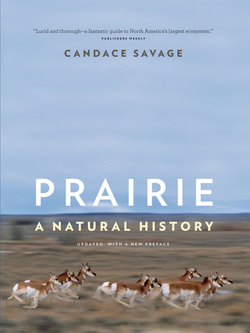Читать книгу Prairie - Candace Savage - Страница 37
На сайте Литреса книга снята с продажи.
ОглавлениеPrairie grasses also have another ingenious way of evading the demands of the sun. Like many other grassland creatures (prairie dogs, ground squirrels, cottontails, badgers, and so on), they take refuge underground. What we think of as “grass”—the aboveground leaves and stems—actually constitutes less than half of the organism. Between 60 and 80 percent of the plant, by weight, typically grows below ground. The roots extend down from the base of the stems like a tangled head of hair, as main roots divide into minor roots and then into root hairs. A 10-foot (3-meter) stand of big bluestem is anchored under ground by a mass of coarse, fibrous roots that reaches as much as a good 12 feet (or 3.6 meters) into the earth. Blue grama, for its part, seldom lifts its seed heads very far above the ground, but its network of fine, branching roots can sometimes probe the soil for water almost 6 feet (2 meters) down!
These extensive systems of roots push thirstily through the soil, intent on sucking up every available drop of water. But if the soil is very dry, as it is during periods of drought, the roots can’t draw in enough moisture to keep pace with losses from the stomata. Grasses respond by transferring their most valuable resources (including sugars and proteins) from their leaves into their roots and, especially, into their rhizomes—those aggressive, underground stems that are familiar to anyone who has ever battled with quack grass in the garden. Dead to the world above ground—withered and crisp—the plants live frugally below the surface, drawing on their cached supplies and biding their time until the weather improves. When the rains eventually return, as inevitably they do, the grasses explode into action, sending out fresh rhizomes, which in turn put out fresh leaves and roots, to produce a burgeoning network of tender growth. The amazingly resilient blue grama can revive from dormancy, green up, and grow on as little as .2 inches, or 5 millimeters, of rainfall.
Prairie grasses are not all equally capable of coping with drought. In general, tall grasses, including big bluestem and other shoulder-high species such as switchgrass and Indian grass, require the most moisture, while short grasses like blue grama, galleta, and the stubby little buffalo grass are the most resistant to drought. Midheight species, including needle-and-thread grass, rough fescue, and western wheatgrass (a.k.a. bluejoint, for its bluish leaf nodes), tend to fall somewhere in between. But all prairie grasses can contend with drought more successfully than can most deciduous trees—which is why the prairies are prairies instead of forests. The grasslands are an expression of the drought-prone prairie climate and a living response to the geography of the midcontinent.
